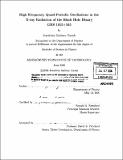| dc.contributor.advisor | Ronald A. Remillard. | en_US |
| dc.contributor.author | Gazak, Jonathan Zachary | en_US |
| dc.contributor.other | Massachusetts Institute of Technology. Dept. of Physics. | en_US |
| dc.date.accessioned | 2007-02-21T11:35:19Z | |
| dc.date.available | 2007-02-21T11:35:19Z | |
| dc.date.copyright | 2006 | en_US |
| dc.date.issued | 2006 | en_US |
| dc.identifier.uri | http://hdl.handle.net/1721.1/36128 | |
| dc.description | Thesis (S.B.)--Massachusetts Institute of Technology, Dept. of Physics, 2006. | en_US |
| dc.description | Includes bibliographical references (p. 93-94). | en_US |
| dc.description.abstract | GRS 1915+105 is an accreting black-hole in a binary system located in the Milky Way. It is one of the most variable X-ray sources known, and 12 variability classifications have been defined, many of which appear to be repetitive cycles of accretion instability. We study one particular variability type, the p cycle, which is selected for its high frequency quasi-periodic oscillations (HFQPOs) and recurring double-peak flare in the light curve. We investigate the primary properties of the 82 p-type observations collected by RXTE. The range in flare recurrence time () is 33.73 s < T < 122.49 s, with <> ± asample = 65.44 ± 19.83 s. The flaring fraction , defined by percent of cycle exposure > 1.2*mean count rate, ranges 12.11% < ( < 37.61%, with <> ± asample = 20.05 ± 5.33%. We find a correlation between T and ( which divides the 82 observations into three sub-classes: pi; slow with low , P2; fast with low , and P3; fast with high . The evolution between sub-classes suggests two driving mechanisms, an unknown mechanism limiting T > 33 s and a process consistent with the Eddington limit that increases (at the lower limit of ) for the p3 group. | en_US |
| dc.description.abstract | (cont.) For each subclass we study the emission properties in four phase zones of the p cycle, where the phases are defined on the basis of the X-ray count rate (X) and soft color (S; rates at 6-12 keV / 2-5 keV). Two HFQPOs in the p cycle are isolated to different zones and sub-classes: one at 67 Hz is localized to the second (hard-spectrum) flare, and another QPO at 150 Hz in the low X, low S phase zone of the pi group. All phase zones display low-frequency QPOs, and they are particularly strong in the low-X, low-S zone (7.5 Hz) and the low-X, high-S zone (10.5 Hz). Classifications of X-ray spectral states for each zone indicate no zones in the thermal state, flaring zones (high X) in the steep power law (SPL) state, and quiet zones (low X) in either the hard or hard:SPL intermediate state. We conclude that the p cycle provides special opportunities to further study an instability cycle that is driven, in part, by the Eddington limit and that portions of the cycle contain the mechanism that produces two different HFQPOs. Further investigations should be made with increased phase resolution and with additional strategies to define the phases of the p cycle. | en_US |
| dc.description.statementofresponsibility | by Jonathan Zachary Gazak. | en_US |
| dc.format.extent | 94 p. | en_US |
| dc.language.iso | eng | en_US |
| dc.publisher | Massachusetts Institute of Technology | en_US |
| dc.rights | M.I.T. theses are protected by copyright. They may be viewed from this source for any purpose, but reproduction or distribution in any format is prohibited without written permission. See provided URL for inquiries about permission. | en_US |
| dc.rights.uri | http://dspace.mit.edu/handle/1721.1/7582 | |
| dc.subject | Physics. | en_US |
| dc.title | High frequency quasi-periodic oscillations in the X-ray radiation of the black hole binary GRS 1915+105 | en_US |
| dc.type | Thesis | en_US |
| dc.description.degree | S.B. | en_US |
| dc.contributor.department | Massachusetts Institute of Technology. Department of Physics | |
| dc.identifier.oclc | 72467863 | en_US |
